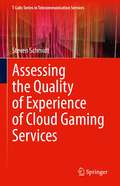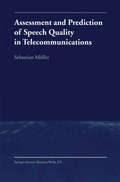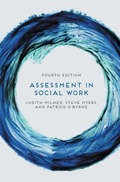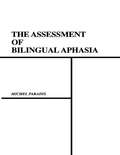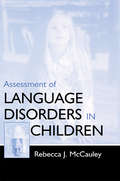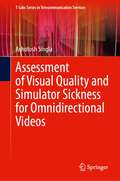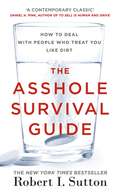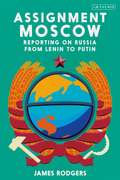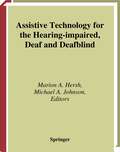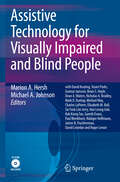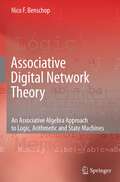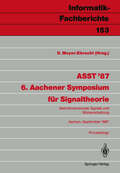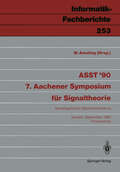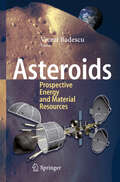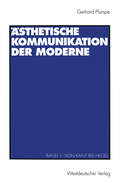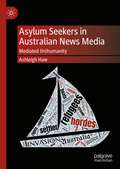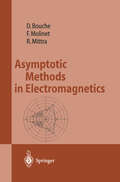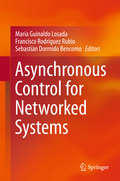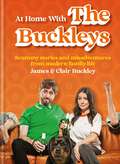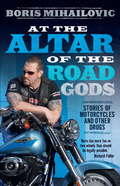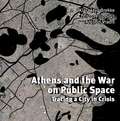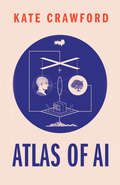- Table View
- List View
Assessing the Quality of Experience of Cloud Gaming Services (T-Labs Series in Telecommunication Services)
by Steven SchmidtThis book provides an overview of concepts and challenges in intis investigated using structural equation modeling. The conveyed understanding of gaming QoE, empirical eraction quality in the domain of cloud gaming services. The author presents a unified evaluation approach by combining quantitative subjective assessment methods in a concise way. The author discusses a measurement tool, Gaming Input Quality Scale (GIPS), that assesses the interaction quality of such a service available. Furthermore, the author discusses a new framework to assess gaming Quality of Experience (QoE) using a crowdsourcing approach. Lastly, based on a large dataset including dominant network and encoding conditions, the evaluation method is investigated using structural equation modeling. The conveyed understanding of gaming QoE, empirical findings, and models presented in this book should be of particular interest to researchers working in the fields of quality and usability engineering, as well as service providers and network operators.
Assessment and Prediction of Speech Quality in Telecommunications
by Sebastian MöllerThe quality of a telecommunication voice service is largely inftuenced by the quality of the transmission system. Nevertheless, the analysis, synthesis and prediction of quality should take into account its multidimensional aspects. Quality can be regarded as a point where the perceived characteristics and the desired or expected ones meet. A schematic is presented which classifies different entities which contribute to the quality of a service, taking into account conversational, user as weIl as service related contributions. Starting from this concept, perceptively relevant constituents of speech communication quality are identified. The perceptive factors result from ele ments of the transmission configuration. A simulation model is developed and implemented which allows the most relevant parameters of traditional trans mission configurations to be manipulated, in real time and for the conversation situation. Inputs into the simulation are instrumentally measurable quality elements commonly used in transmission planning of telephone networks. A reduced set of these quality elements forms a basis for models which aim at predicting mouth-to-ear quality as it would be perceived by a user of the sys tem. These models are an important tool for the planner of telecommunication networks, as they allow the expected quality to be estimated in advance, even before the network has been set up. Two well-known models (the SUBMOD and the E-model) are analyzed in more detail, with an emphasis on the psy choacoustic and psychophysical backgrounds.
Assessment in Social Work
by Judith Milner Steve Myers Patrick O'byrneAssessment is a crucial social work task. Yet there is so much to consider that it can sometimes feel overwhelming. This core text book gives you structured, practical guidance on how to approach this vital professional skill. In a clear and accessible style, the authors provide both the theory behind assessment as well as helpful practice examples. Whether on a qualifying course or returning to study, this fully revised edition of a tried-and-tested text gives social work students and practitioners a coherent and reliable guide to best practice. At the heart of this authoritative book is a set of theoretical maps to guide social workers' thinking and decision-making when undertaking assessment.
The Assessment of Bilingual Aphasia (Neuropsychology and Neurolinguistics Series)
by Michel Paradis Gary LibbenThe Bilingual Aphasia Test is a comprehensive language test designed to assess the differential loss or sparing of various language functions in previously bilingual individuals. The individual is tested, separately, in each language he or she previously used, and then in the two languages simultaneously. The testing is multimodal -- sampling hearing, speaking, reading, and writing; and multidimensional -- testing various linguistic levels (phonological, morphological, syntactic, lexical, and semantic), tasks (comprehension, repetition, judgment, lexical access and propositionizing), and units (words, sentences, and paragraphs). The BAT is structured as follows: * To test a bilingual aphasic, you will need the following testing elements: the stimulus books for each of the languages in which the individual was formerly fluent, the single-language tests for each of these languages, as well as the bilingual test that links them. For example, if you are testing an English-French bilingual aphasic, you will need an English stimulus book, a French stimulus book, an English single-language test, a French single-language test, and an English-French bilingual test. * The BAT can also be used to test monolingual aphasics. To test for monolingual aphasia, you will need the stimulus book and the single-language test in the language in which the individual was formerly fluent. * Professor Paradis' book, The Assessment of Bilingual Aphasia, provides the background material and serves as the manual for the test. The BAT is available in dozens of languages and language pairs. There are now 106 bilingual pairs available. Additional single-language and bilingual tests are being prepared continuously. If the language (or language pair) you need is not listed, please call LEA to find out if and when it will be available. Single-language materials are now available in: Amharic Arabic (Jordanian) Arabic (Maghrebian) Armenian (Eastern) Armenian (Western) Azari Basque Berber Bulgarian Catalán Chinese (Cantonese) Chinese (Mandarin) Croatian Czech Danish Dutch English Farsi Finnish French Friulian Galician German Greek Hebrew Hindi Hungarian Icelandic Inuktitut Italian Japanese Kannada Korean Kurdish Latvian Lithuanian Luganda Malagasy Norwegian Oryia Polish Portuguese (Brazilian) Portuguese (European) Rumanian Russian Somali Spanish (American) Spanish (European) Swahili Swedish Tagalog Tamil Turkish Ukrainian Urdu Vietnamese Yiddish Bilingual pairs are now available in: Amharic/English Amharic/French Arabic/Armenian Arabic/English Arabic/French Arabic/Somali Arabic/Swahili Armenian/English Armenian/Farsi Armenian/French Armenian/Russian Basque/English Basque/French Basque/Spanish Berber/English Berber/French Bulgarian/English Bulgarian/French Bulgarian/German Bulgarian/Russian Catalán/Spanish Chinese (Cantonese)/English Chinese (Mandarin)/English Chinese/French Croatian/English Croatian/French Croatian/Italian Czech/English Czech/German Czech/Russian Czech/Swedish Danish/English Danish/German Dutch/English Dutch/French Dutch/German Dutch/Hebrew English/Farsi English/Finnish English/French English/Friulian English/German English/Greek English/Hebrew English/Hindi English/Hungarian English/Icelandic English/Italian English/Japanese English/Korean English/Latvian English/Lithuanian English/Luganda English/Norwegian English/Polish English/Portuguese English/Rumanian English/Russian En
The Assessment of Bilingual Aphasia (Neuropsychology and Neurolinguistics Series)
by Michel Paradis Gary LibbenThe Bilingual Aphasia Test is a comprehensive language test designed to assess the differential loss or sparing of various language functions in previously bilingual individuals. The individual is tested, separately, in each language he or she previously used, and then in the two languages simultaneously. The testing is multimodal -- sampling hearing, speaking, reading, and writing; and multidimensional -- testing various linguistic levels (phonological, morphological, syntactic, lexical, and semantic), tasks (comprehension, repetition, judgment, lexical access and propositionizing), and units (words, sentences, and paragraphs). The BAT is structured as follows: * To test a bilingual aphasic, you will need the following testing elements: the stimulus books for each of the languages in which the individual was formerly fluent, the single-language tests for each of these languages, as well as the bilingual test that links them. For example, if you are testing an English-French bilingual aphasic, you will need an English stimulus book, a French stimulus book, an English single-language test, a French single-language test, and an English-French bilingual test. * The BAT can also be used to test monolingual aphasics. To test for monolingual aphasia, you will need the stimulus book and the single-language test in the language in which the individual was formerly fluent. * Professor Paradis' book, The Assessment of Bilingual Aphasia, provides the background material and serves as the manual for the test. The BAT is available in dozens of languages and language pairs. There are now 106 bilingual pairs available. Additional single-language and bilingual tests are being prepared continuously. If the language (or language pair) you need is not listed, please call LEA to find out if and when it will be available. Single-language materials are now available in: Amharic Arabic (Jordanian) Arabic (Maghrebian) Armenian (Eastern) Armenian (Western) Azari Basque Berber Bulgarian Catalán Chinese (Cantonese) Chinese (Mandarin) Croatian Czech Danish Dutch English Farsi Finnish French Friulian Galician German Greek Hebrew Hindi Hungarian Icelandic Inuktitut Italian Japanese Kannada Korean Kurdish Latvian Lithuanian Luganda Malagasy Norwegian Oryia Polish Portuguese (Brazilian) Portuguese (European) Rumanian Russian Somali Spanish (American) Spanish (European) Swahili Swedish Tagalog Tamil Turkish Ukrainian Urdu Vietnamese Yiddish Bilingual pairs are now available in: Amharic/English Amharic/French Arabic/Armenian Arabic/English Arabic/French Arabic/Somali Arabic/Swahili Armenian/English Armenian/Farsi Armenian/French Armenian/Russian Basque/English Basque/French Basque/Spanish Berber/English Berber/French Bulgarian/English Bulgarian/French Bulgarian/German Bulgarian/Russian Catalán/Spanish Chinese (Cantonese)/English Chinese (Mandarin)/English Chinese/French Croatian/English Croatian/French Croatian/Italian Czech/English Czech/German Czech/Russian Czech/Swedish Danish/English Danish/German Dutch/English Dutch/French Dutch/German Dutch/Hebrew English/Farsi English/Finnish English/French English/Friulian English/German English/Greek English/Hebrew English/Hindi English/Hungarian English/Icelandic English/Italian English/Japanese English/Korean English/Latvian English/Lithuanian English/Luganda English/Norwegian English/Polish English/Portuguese English/Rumanian English/Russian En
Assessment of Language Disorders in Children
by Rebecca J. McCauleyThis book constitutes a clear, comprehensive, up-to-date introduction to the basic principles of psychological and educational assessment that underlie effective clinical decisions about childhood language disorders. Rebecca McCauley describes specific commonly used tools, as well as general approaches ranging from traditional standardized norm-referenced testing to more recent ones, such as dynamic and qualitative assessment. Highlighting special considerations in testing and expected patterns of performance, she reviews the challenges presented by children with a variety of problems--specific language impairment, hearing loss, mental retardation, and autism spectrum disorders. Three extended case examples illustrate her discussion of each of these target groups. Her overarching theme is the crucial role of well-formed questions as fundamental guides to decision making, independent of approach.Each chapter features lists of key concepts and terms, study questions, and recommended readings. Tables throughout offer succinct summaries and aids to memory.Students, their instructors, and speech-language pathologists continuing their professional education will all welcome this invaluable new resource. Distinctive features include: A comprehensive consideration of both psychometric and descriptive approaches to the characterization of children's language A detailed discussion of background issues important in the language assessment of the major groups of children with language impairment Timely information on assessment of change--a topic frequently not covered in other texts Extensive guidance on how to evaluate individual norm-referenced measures for adoption An extensive appendix listing about 50 measures used to assess language in children A test review guide that can be reproduced for use by readers.
Assessment of Language Disorders in Children
by Rebecca J. McCauleyThis book constitutes a clear, comprehensive, up-to-date introduction to the basic principles of psychological and educational assessment that underlie effective clinical decisions about childhood language disorders. Rebecca McCauley describes specific commonly used tools, as well as general approaches ranging from traditional standardized norm-referenced testing to more recent ones, such as dynamic and qualitative assessment. Highlighting special considerations in testing and expected patterns of performance, she reviews the challenges presented by children with a variety of problems--specific language impairment, hearing loss, mental retardation, and autism spectrum disorders. Three extended case examples illustrate her discussion of each of these target groups. Her overarching theme is the crucial role of well-formed questions as fundamental guides to decision making, independent of approach.Each chapter features lists of key concepts and terms, study questions, and recommended readings. Tables throughout offer succinct summaries and aids to memory.Students, their instructors, and speech-language pathologists continuing their professional education will all welcome this invaluable new resource. Distinctive features include: A comprehensive consideration of both psychometric and descriptive approaches to the characterization of children's language A detailed discussion of background issues important in the language assessment of the major groups of children with language impairment Timely information on assessment of change--a topic frequently not covered in other texts Extensive guidance on how to evaluate individual norm-referenced measures for adoption An extensive appendix listing about 50 measures used to assess language in children A test review guide that can be reproduced for use by readers.
Assessment of Visual Quality and Simulator Sickness for Omnidirectional Videos (T-Labs Series in Telecommunication Services)
by Ashutosh SinglaThis book presents extensive research on the quality of 360° video perceived by users with HMDs. The book aims to develop a set of standard guidelines for the systematic visual quality assessment of 360° videos. Firstly, conventional subjective test methods such as Absolute Category Rating (ACR) and Double Stimulus Impairment Scale (DSIS) are applied to evaluate video quality, alongside the Modified ACR (M-ACR) method newly proposed. Building on the reliability and general applicability of the procedure across different tests, a methodological framework for 360° video quality assessment is then presented. The author also analyzes simulator sickness to investigate the impact of different influencing factors. The insights gained on simulator sickness related to 360° video contribute to a better understanding of this particular use case of VR and can help to improve comfort among users by suggesting improvements in the technical specifications of 360° video and HMD technology and thus improving QoE.
The Asshole Survival Guide: How to Deal with People Who Treat You Like Dirt
by Robert I SuttonFrom the international bestselling expert on dealing with assholes'With cutting-edge research and real-life examples that are thought-provoking and often hilarious, thisis an indispensable resource'Gretchen Rubin, author of The Happiness Project'At last someone has provided clear steps for rejecting, deflecting, and deflating the jerks who blight our lives. Better still, that someone is the great Bob Sutton, which ensures that the information is useful, evidence-based, and fun to read'Robert Cialdini, author of Influence and Pre-Suasion'If only Bob Sutton's book had been available to help me deal with the full complement of 1st-class assholes I've encountered in my 50-year professional life. No names shall be mentioned'Tom Peters, co-author of In Search of ExcellenceBeing around assholes, whether at work or elsewhere, can damage performance and affect wellbeing: having one asshole in a team has been shown to reduce performance by 30 to 40%. And social media has only given rise to further incivility -- 40% of people have experienced harassment online.In The Asshole Survival Guide, Stanford professor Robert Sutton offers practical advice on identifying and tackling any kind of asshole -- based on research into groups from uncivil civil servants to French bus drivers, and 8,000 emails that he has received on asshole behaviour.With expertise and humour, he provides a cogent and methodical game-plan. First, he sets out the asshole audit, to find out what kind of asshole needs dealing with, and asshole detection strategies. Then he reveals field-tested, sometimes surprising techniques, from asshole avoidance and asshole taxes to mind-tricks and the art of love bombing. Finally, he explains the dangers of asshole blindness -- when the problem might be yours truly.Readers will learn how to handle assholes - in the workplace and beyond - once and for all!
Assignment Moscow: Reporting on Russia from Lenin to Putin
by James RodgersThe story of western correspondents in Russia is the story of Russia's attitude to the west. Russia has at different times been alternately open to western ideas and contacts, cautious and distant or, for much of the twentieth century, all but closed off. From the revolutionary period of the First World War onwards, correspondents in Russia have striven to tell the story of a country known to few outsiders. Their stories have not always been well received by political elites, audiences, and even editors in their own countries-but their accounts have been a huge influence on how the West understands Russia. Not always perfect, at times downright misleading, they have, overall, been immensely valuable. In Assignment Moscow, former foreign correspondent James Rodgers analyses the news coverage of Russia throughout history, from the coverage of the siege of the Winter Palace and a plot to kill Stalin, to the Chernobyl explosion and the Salisbury poison scandal.
Assignment Moscow: Reporting on Russia from Lenin to Putin
by James RodgersThe story of western correspondents in Russia is the story of Russia's attitude to the west. Russia has at different times been alternately open to western ideas and contacts, cautious and distant or, for much of the twentieth century, all but closed off. From the revolutionary period of the First World War onwards, correspondents in Russia have striven to tell the story of a country known to few outsiders. Their stories have not always been well received by political elites, audiences, and even editors in their own countries-but their accounts have been a huge influence on how the West understands Russia. Not always perfect, at times downright misleading, they have, overall, been immensely valuable. In Assignment Moscow, former foreign correspondent James Rodgers analyses the news coverage of Russia throughout history, from the coverage of the siege of the Winter Palace and a plot to kill Stalin, to the Chernobyl explosion and the Salisbury poison scandal.
Assistive Technology for the Hearing-impaired, Deaf and Deafblind
by C. Andersson D. Campbell A. Farquharson S. Furner J. Gill A. Jackson J. Lucker K. Nolde E. Werner M. WhybrayAffirmative legislative action in many countries now requires that public spaces and services be made accessible to disabled people. Although this is often interpreted as access for people with mobility impairments, such legislation also covers those who are hearing or vision impaired. In these cases, it is often the provision of advanced technological devices and aids which enables people with sensory impairments to enjoy the theatre, cinema or a public meeting to the full. Assistive Technology for the Hearin-impaired, Deaf and Deafblind shows the student of rehabilitation technology how this growing technical provision can be used to support those with varying reductions in auditory ability and the deafblind in modern society. Features: instruction in the physiology of the ear together with methods of measurement of hearing levels and loss; the principles of electrical engineering used in assistive technology for the hearing impaired; description and demonstration of electrical engineering used in hearing aids and other communications enhancement technologies; explanation of many devices designed for every-day living in terms of generic electrical engineering; sections of practical projects and investigations which will give the reader ideas for student work and for self teaching. The contributors are internationally recognised experts from the fields of audiology, electrical engineering, signal processing, telephony and assistive technology. Their combined expertise makes Assistive Technology for the Hearing-impaired, Deaf and Deafblind an excellent text for advanced students in assistive and rehabilitation technology and to professional engineers and medics working in assistive technology who wish to maintain an up-to-date knowledge of current engineering advances.
Assistive Technology for Visually Impaired and Blind People
by Marion Hersh Michael A. JohnsonEqual accessibility to public places and services is now required by law in many countries. For the vision-impaired, specialised technology often can provide a fuller enjoyment of the facilities of society, from large scale meetings and public entertainments to reading a book or making music. This volume explores the engineering and design principles and techniques used in assistive technology for blind and vision-impaired people. This book maintains the currency of knowledge for engineers and health workers who develop devices and services for people with sight loss, and is an excellent source of reference for students of assistive technology and rehabilitation.
Associative Digital Network Theory: An Associative Algebra Approach to Logic, Arithmetic and State Machines
by Nico F. BenschopAssociative Digital Network Theory is intended for researchers at industrial laboratories,teachers and students at technical universities, in electrical engineering, computer science and applied mathematics departments, interested in new developments of modeling and designing digital networks (DN: state machines, sequential and combinational logic) in general, as a combined math/engineering discipline. As background an undergraduate level of modern applied algebra (Birkhoff-Bartee: Modern Applied Algebra - 1970, and Hartmanis-Stearns: Algebraic Structure of Sequential Machines - 1970) will suffice. Essential concepts and their engineering interpretation are introduced in a practical fashion with examples. The motivation in essence is: the importance of the unifying associative algebra of function composition (viz. semigoup theory) for the practical characterisation of the three main functions in computers, namely sequential logic (state-machines), arithmetic and combinational (Boolean) logic.
ASST ’87 6. Aachener Symposium für Signaltheorie: Mehrdimensionale Signale und Bildverarbeitung Aachen, 9.–12. September 1987 (Informatik-Fachberichte #153)
by Dietrich Meyer-EbrechtIm September 1987 fand zum sechsten Mal das Aachener Symposium für Signaltheorie statt. Ingenieure, Informatiker, Physiker und Mathematiker stellten dort ihre neuesten Forschungsergebnisse aus dem Bereich der Signaltheorie bzw. deren Anwendung vor. Das 6. ASST widmete sich schwerpunktmäßig den mehrdimensionalen Signalen und der Bildverarbeitung. Mit den Themenbereichen Theorie mehrdimensionaler Signale, Methodik, Bildcodierung, Technologie der Bildverarbeitung und Anwendungen gibt der vorliegende Band einen Überblick über den aktuellen Stand der Forschung auf dem immer mehr Bedeutung gewinnenden Gebiet der Bildverarbeitung.
ASST ’90 7. Aachener Symposium für Signaltheorie: Modellgestützte Signalverarbeitung Aachen, 12.–14. September 1990 Proceedings (Informatik-Fachberichte #253)
by W. AmelingDas seit 1975 im ein- bis dreijährigen Turnus ausgerichtete "Aachener Symposium für Signaltheorie" - früher "Aachener Kolloquium" - widmet sich schwerpunktmäßig den theoretischen Grundlagen der Signalverarbeitung. Es erlangt dadurch eine besondere Bedeutung, daß die Bezüge zur Anwendung und Technologie integraler Bestandteil dieser Veranstaltung sind. Die diesjährige Tagung wurde unter dem Thema "Modellgestützte Signalverarbeitung" durchgeführt. Themenschwerpunkte bildeten dabei die modellgestützte Verarbeitung, Modelle, Algorithmen und Architekturen. Diese Themenwahl trägt insgesamt der Tatsache Rechnung, daß in zunehmend aufwendigeren Signalverarbeitungsprozessen die zugrundeliegenden abstrakten Verarbeitungsmodelle, deren theoretische Behandlung und Implementierung einer auf vielen Sichtweisen beruhenden Strukturierung bedürfen. Der vorliegende Tagungsband repräsentiert nicht nur aktuelle Ergebnisse zu speziellen Forschungsgebieten, sondern stellt zugleich eine Plattform für die Verständigung der involvierten Fachrichtungen (Ingenieurwissenschaften, Mathematik, Informatik, Physik, Biologie etc.) untereinander dar.
Asteroids: Prospective Energy and Material Resources
by Viorel BadescuThe Earth has limited material and energy resources while these resources in space are virtually unlimited. Further development of humanity will require going beyond our planet and exploring of extraterrestrial resources and sources of unlimited power. Thus far, all missions to asteroids have been motivated by scientific exploration. However, given recent advancements in various space technologies, mining asteroids for resources is becoming ever more feasible. A significant portion of asteroids value is derived from their location; the required resources do not need to be lifted at a great expense from the surface of the Earth. Resources derived from Asteroid not only can be brought back to Earth but could also be used to sustain human exploration of space and permanent settlements in space. This book investigates asteroids' prospective energy and material resources. It is a collection of topics related to asteroid exploration, and utilization. It presents past and future technologies and solutions to old problems that could become reality in our life time. The book therefore is a great source of condensed information for specialists involved in current and impending asteroid-related activities and a good starting point for space researchers, inventors, technologists and potential investors. Written for researchers, engineers, and businessmen interested in asteroids' exploration and exploitation. Keywords: Asteroids, Asteroid exploration, Asteroid exploitation, Energy sources, Space Resources, Material Resources, In-Situ Resource Utilization, Mining
Ästhetische Kommunikation der Moderne: Band 1: Von Kant bis Hegel
by Gerhard PlumpeAuf die Ausdifferenzierung der Literatur und Kunst zu einem modernen Sozialsystem reagierte die Philosophie mit der Ausbildung ästhetischer Kommunikation. Deren Geschichte um 1800 wird als Versuch rekonstruiert, die "Autonomie" der Kunst als epochales Ereignis zu begründen, aber auch als Prämisse anspruchsvoller Leistungserwartungen zu überfordern, der Beobachtung sozialer Differenzierungsprozesse werden Mythen der Totalität im Medium der Kunsterfahrung entgegengestellt. Diese romantische Paradoxierung der Kunstautonomie wird in Hegels Ästhetik kritisch reflektiert und durch eine auch soziologisch orientierte Perspektive ersetzt, die der Partikularität moderner Kunst zu entsprechen sucht."(...) Angesichts der Komplexität des Themas und der analysierten philosophischen Positionen überzeugt Plumpes Darstellung durch Klarheit und Zugänglichkeit. Zur Einarbeitung in ästhetische Fragestellungen sowie als Hintergrundinformation zu allen mit der Entwicklung moderner Kunst befaßten Überlegungen ist Gerhard Plumpes 'Ästhetische Kommunikation der Moderne' daher unbedingt zu empfehlen."Literatur in Wissenschaft und Unterricht, XXVII/1-1994
Asylum Seekers in Australian News Media: Mediated (In)humanity
by Ashleigh HawThis book sheds light on how the public engage with, make sense of, and discursively evaluate news media constructions of people from asylum seeking backgrounds. As a case study, the author discusses her recent research combining Critical Discourse Analysis with a cultural studies Audience Reception framework to examine the perspectives of 24 Western Australians who took part in semi-structured interviews. During their interviews, participants were asked open-ended questions about: their general views on people seeking asylum, including Australia’s policy responses, their media engagement habits and preferences, and their views concerning how the Australian media represents people seeking asylum. The author compares and contrasts this research with broader interdisciplinary discussion, and the book will therefore appeal to students and scholars of migration, political communication, sociology, audience reception, critical media studies and sociolinguistics.
Asymptotic Methods in Electromagnetics
by Daniel Bouche Frederic Molinet Raj MittraNumerically rigorous techniques for the computation of electromagnetic fields diffracted by an object become computationally intensive, if not impractical to handle, at high frequencies and one must resort to asymptotic methods to solve the scattering problem at short wavelengths. The asymptotic methods provide closed form expansions for the diffracted fields and are also useful for eliciting physical interpretations of the various diffraction phenomena. One of the principal objectives of this book is to discuss the different asymptotic methods in a unified manner. Although the book contains explicit formulas for computing the field diffracted by conducting or dielectric-coated objects, it also provides the mathematical foundations of the different methods and explains how they are interrelated.
Asynchronous Control for Networked Systems
by María Guinaldo Losada Francisco Rodríguez Rubio Sebastián Dormido BencomoThis book sheds light on networked control systems; it describes different techniques for asynchronous control, moving away from the periodic actions of classical control, replacing them with state-based decisions and reducing the frequency with which communication between subsystems is required. The text focuses specially on event-based control.Split into two parts, Asynchronous Control for Networked Systems begins by addressing the problems of single-loop networked control systems, laying out various solutions which include two alternative model-based control schemes (anticipatory and predictive) and the use of H2/H∞ robust control to deal with network delays and packet losses. Results on self-triggering and send-on-delta sampling are presented to reduce the need for feedback in the loop. In Part II, the authors present solutions for distributed estimation and control. They deal first with reliable networks and then extend their results to scenarios in which delays and packet losses may occur.The novel results presented in Asynchronous Control for Networked Systems are transmitted in a concise and clear style supported by simulation and experimental examples. Some applications are also provided.Academic researchers and graduate students investigating control theory, control engineering and computer communications systems can use this monograph to learn how asynchronous control helps tackle the problems of networked systems in centralized and distributed schemes. Control practitioners at work in power systems, vehicle coordination and traffic networks will also find this book helpful in improving the performance of their systems.
At Home With The Buckleys: Scummy stories and misadventures from modern family life
by James & BuckleyCLAIR: We've been let loose on a book... whose bright idea was that?JAMES: We haven't got anything to say!CLAIR: Don't tell them that before they buy it...JAMES: They'll work it out eventually!CLAIR: Well, we've managed to put together some bits and pieces that might be interesting - or at least funny/weird/silly.JAMES: Probably not.CLAIR: No... probably not. Though if you like the vlogs, you might like it?JAMES: No one likes the vlogs.CLAIR: True.JAMES: Anyway, enjoy!At Home with The Buckleys is one couple's take on the wild ride that is modern marriage, parenting and adulting. Told from both sides, Clair and James share a collection of hilarious stories and comedy excursions from their early lives, years of cult TV fame, having children and setting up their YouTube channel.
At the Altar of the Road Gods: Stories of motorcycles and other drugs
by Boris MihailovicCaution: Contains incidents of insane motorcycle antics, drug use and swearing.'Boris has more fun on two wheels than should be legally possible.' - Richard Fidler, ABCHis mother may not know it but Boris Mihailovic has lived a fast, furious, often politically incorrect life chasing the epiphanies of speed (the sensation not the drug). For Boris, motorbike riding was the rite of passage into manhood he'd been searching for. Now, nearly 40 years since he first rode a bike, the wisdom of age has provided the perspective for Boris to look back and realise some pretty wild shit went down. At the Altar of the Road Gods is about popping your motorcycle-buying cherry with an XJ650 Yamaha. It's about fines, feuds and fractures, high-sides, tank-slappers, angry police, even angrier young men, crashing, getting up, cranky girlfriends, riding faster, outlaws, and partaking in copious amounts of alcohol and drugs. It is about mateship and motorcycles. Ultimately, it is about four decades of two-wheel-related mayhem. Just don't tell Boris's mum! Be warned: may cause laughter, sleeplessness and the desire to buy a Lucifer-black Katana.
Athens and the War on Public Space: Tracing a City in Crisis (PDF)
by Klara Jaya Brekke Christos Filippidis Antonis VradisSometimes, the maelstrom of a crisis can be captured in a single image. The image of the mundane, barely noticeable movement of an urban dweller as they go about their everyday life. Athens and the War on Public Space commences from images just like this one, collected over a two-year period of research (2012–2014) in the Greek capital city. These images, gathered by a team of artist-researchers working to trace and study crisis-ridden urban public spaces in Athens, Greece, create a visual timeline for navigating through all that happened over those two troubled years. The resulting catalog shows how images of shipwrecks and disaster were used to harden anti-migratory policies, and how these exact policies then helped to foster the hatred that spilled onto the streets of Athens, in the form of racist attacks. Athens and the War on Public Space further outlines the violence inherent in the images of silent commuters going about daily life despite the catastrophe, caught in the freeze-frame of inaction as the world around them changes beyond recognition. The carefully curated images show how the crisis was quite literally played out in the city of Athens, especially vis-a-vis its performative construction in the images of anti-migratory policies, state repression, and their material, grave consequences. Athens and the War on Public Space is ultimately a collective portrait of a city caught in the whirlwind of crisis. The book is a compilation of work done during the larger Crisis-Scape project. The team comprised Klara Jaya Brekke, Dimitris Dalakoglou, Ross Domoney, Christos Filippidis, and Antonis Vradis.
The Atlas of AI: Power, Politics, and the Planetary Costs of Artificial Intelligence
by Kate CrawfordThe hidden costs of artificial intelligence, from natural resources and labor to privacy and freedom What happens when artificial intelligence saturates political life and depletes the planet? How is AI shaping our understanding of ourselves and our societies? In this book Kate Crawford reveals how this planetary network is fueling a shift toward undemocratic governance and increased inequality. Drawing on more than a decade of research, award-winning science, and technology, Crawford reveals how AI is a technology of extraction: from the energy and minerals needed to build and sustain its infrastructure, to the exploited workers behind “automated” services, to the data AI collects from us. Rather than taking a narrow focus on code and algorithms, Crawford offers us a political and a material perspective on what it takes to make artificial intelligence and where it goes wrong. While technical systems present a veneer of objectivity, they are always systems of power. This is an urgent account of what is at stake as technology companies use artificial intelligence to reshape the world.
